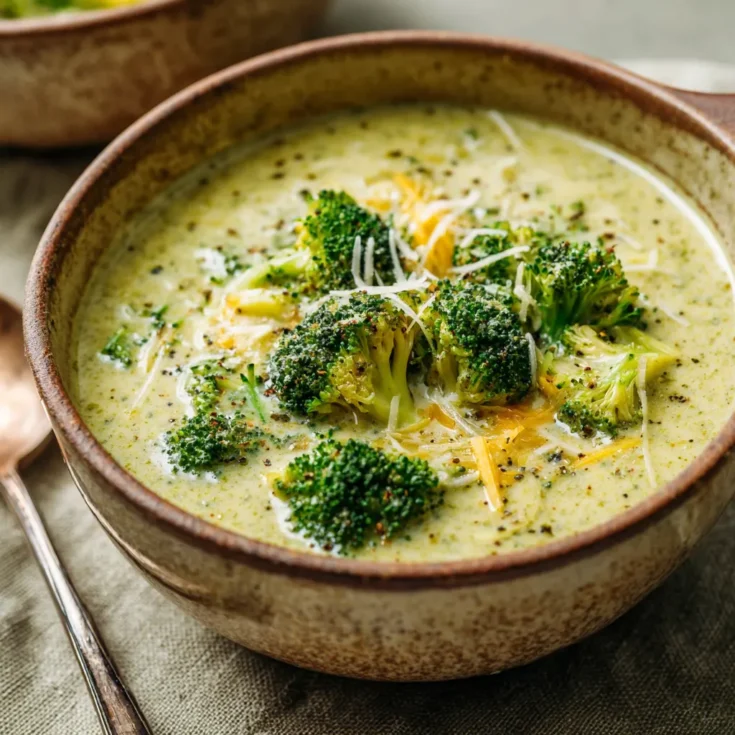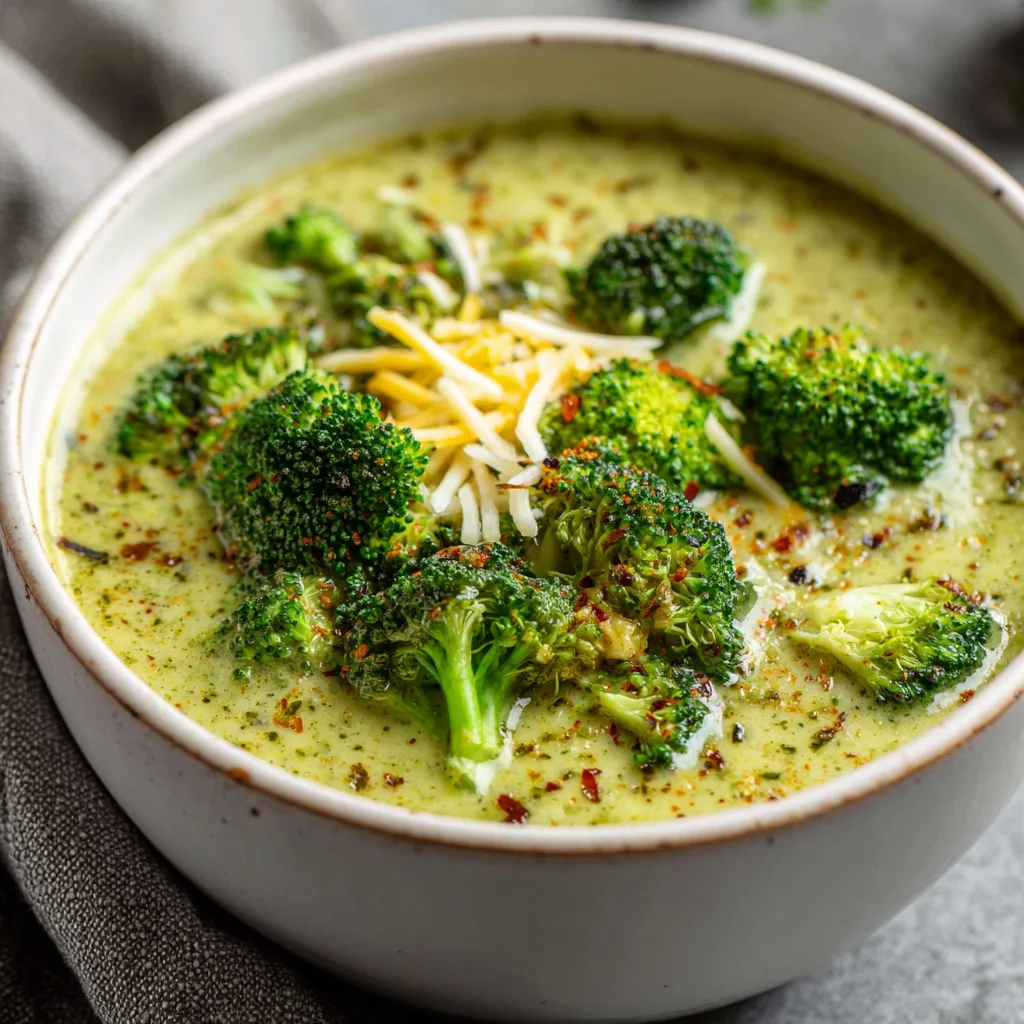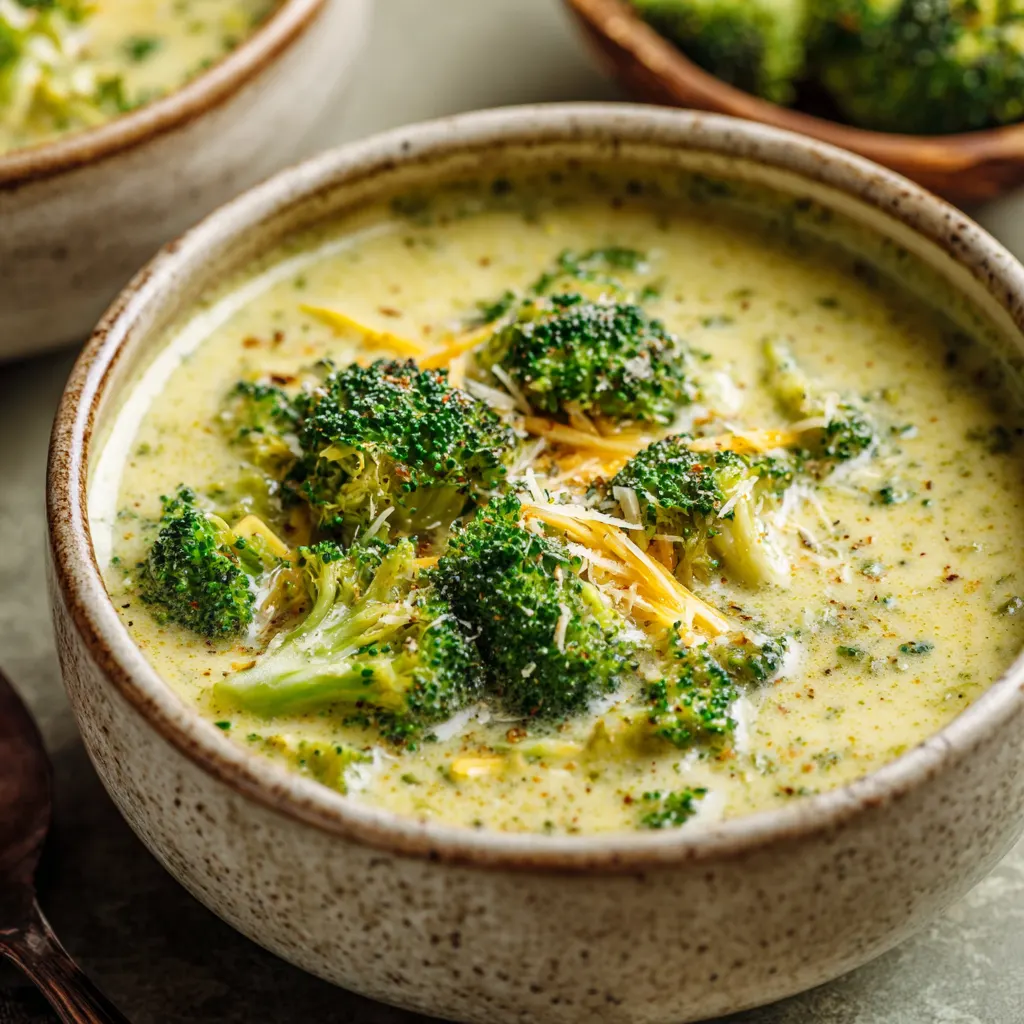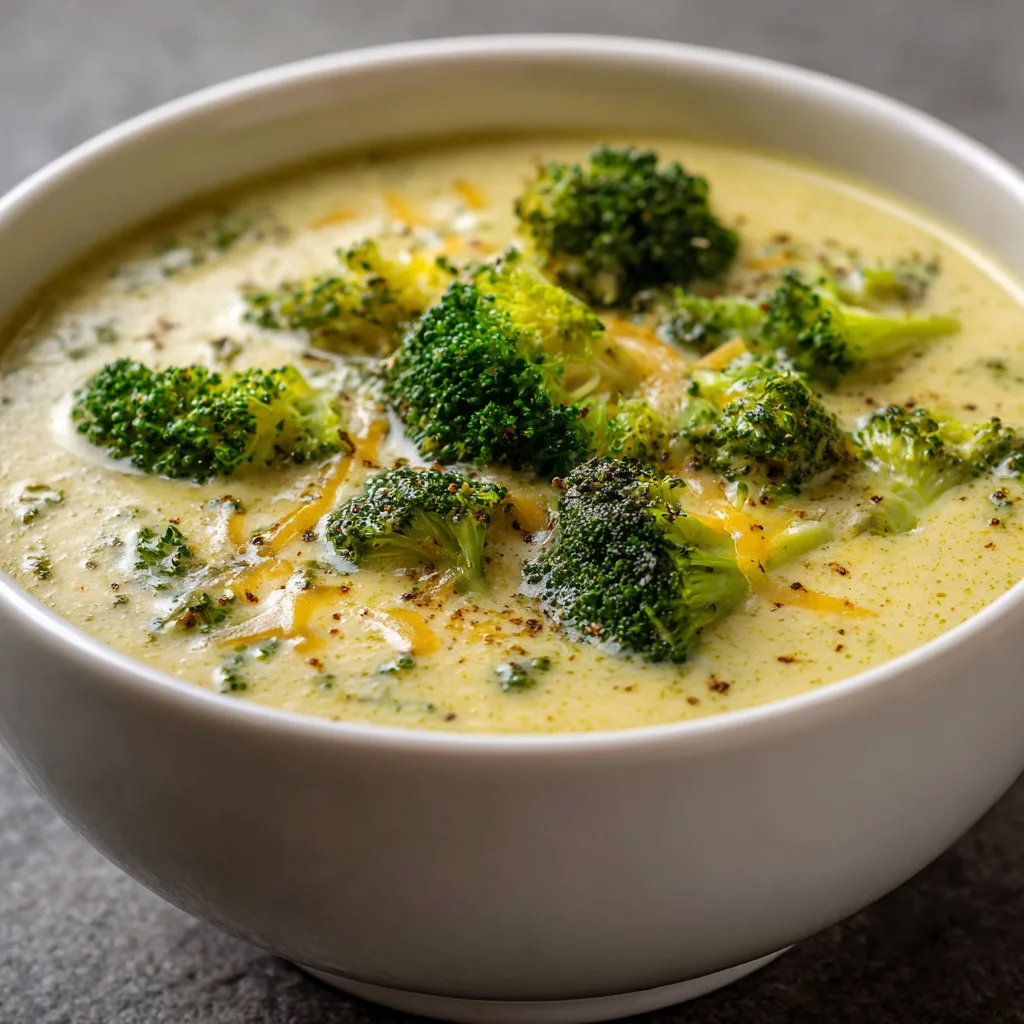What Is One-Pot Broccoli Soup?
One-pot broccoli soup is a delicious and creamy dish where all ingredients cook together in a single pot. This method makes preparation easy and cleanup quick, perfect for busy days. Combining broccoli with savory aromatics, broth, and a touch of cream or cheese, it delivers rich flavor with minimal effort. The beauty of one-pot cooking lies in its simplicity—everything simmers together, allowing flavors to meld and develop naturally.
This soup has surged in popularity among home cooks. People love it because it offers comfort without complicated steps. It’s ideal for anyone craving a warm, nourishing meal that doesn’t require multiple pans or long cooking times. The recipe fits perfectly into busy lifestyles while satisfying cravings for wholesome, home-cooked food.
Broccoli, the star ingredient, is a nutritional powerhouse. It boasts high levels of vitamins C and K, both essential for immune support and bone health. Additionally, broccoli provides a generous dose of dietary fiber, which aids digestion and promotes fullness. Antioxidants in broccoli help fight inflammation and protect cells from damage. With one-pot broccoli soup, you enjoy these health benefits wrapped in a comforting bowl of creamy goodness. This blend of nutrition and flavor makes the soup an excellent choice for a quick, healthy meal any day.
Essential Ingredients for One-Pot Broccoli Soup: Nutrients and Texture
Broccoli shines as the soup’s centerpiece, offering both texture and powerful nutrition. Fresh or frozen florets bring vibrant green color and a satisfying bite. They supply essential vitamins, minerals, and fiber that boost your health with every spoonful. The tender yet slightly crisp broccoli creates a hearty base that carries the soup’s flavor beautifully.
Aromatics like onion, garlic, and celery build a savory foundation for the soup. These ingredients release rich, fragrant flavors when sautéed, awakening the senses and preparing the palate. Their natural sweetness balances broccoli’s earthiness, crafting a harmonious taste profile that invites comfort and warmth.
The soup’s liquid backbone comes from broth, typically vegetable or chicken. This flavorful base simmers all ingredients together, allowing tastes to meld seamlessly. Choosing a good-quality broth elevates the soup’s depth, while vegetable broth keeps it vegetarian-friendly. The broth ensures the soup remains light yet satisfying.
To achieve that creamy texture, many recipes call for heavy cream, whole milk, or plant-based alternatives like coconut or oat milk. These creaminess agents enrich the soup, adding a smooth mouthfeel without overpowering the natural flavors. For those seeking dairy-free versions, nut or soy milks work well and maintain the soup’s luscious consistency.
Cheese rounds out the flavor with richness and a subtle tang. Sharp cheddar is the classic choice, melting smoothly into the warm broth and broccoli mixture. Alternatively, options like gouda or mozzarella add unique notes. For dairy-free diets, vegan cheeses provide a satisfying melt and flavor boost without dairy.
Flavor Enhancers That Elevate One-Pot Broccoli Soup
Adding herbs and spices lifts this soup beyond basic. Thyme and bay leaves bring earthy, aromatic undertones that deepen the flavor profile. A pinch of nutmeg introduces warmth and a gentle spice that complements creamy ingredients. Mustard, especially Dijon, adds a mild tangy kick, balancing richness with brightness.
Acidic components like fresh lemon juice or a splash of vinegar provide balance. These ingredients cut through the creaminess, preventing the soup from feeling heavy. The acidity awakens the flavors, making each bite more vibrant and refreshing.
Seasonings such as salt and black pepper are essential for taste harmony. They enhance all other flavors and allow the natural qualities of broccoli and cheese to shine. For those who enjoy a spicy twist, adding cayenne pepper or red pepper flakes introduces a gentle heat that excites the palate without overwhelming the dish.
Dietary Variations: Making One-Pot Broccoli Soup Fit Every Lifestyle
For vegan and dairy-free diets, this soup easily adapts. Replacing butter with olive oil and using plant-based milk alternatives maintain creaminess without dairy. Vegan cheeses melt well and add flavor, ensuring the soup remains indulgent yet compliant with dietary needs.
Gluten-free versions simply require careful selection of broth and ingredients, all certified gluten-free. Since the soup naturally contains no wheat or gluten, it suits gluten-sensitive individuals perfectly when prepared with the right products.
High-protein variations incorporate beans or legumes like white beans or lentils. These add texture and nutrition, making the soup more filling. Protein boosts also appeal to those seeking balanced meals without sacrificing comfort.
Low-carb alternatives swap potatoes for cauliflower or omit starchy vegetables entirely. This keeps the soup light and suitable for low-carb or ketogenic eating plans. Cauliflower blends smoothly, maintaining creaminess without added carbs.
Each variation ensures this comforting soup meets diverse tastes and dietary goals while retaining its wholesome essence.
Step-by-Step Cooking Process for Perfect One-Pot Broccoli Soup
Start by sautéing aromatics to build a deep flavor base. Heat butter or oil in a large pot over medium heat. Add finely chopped onions, minced garlic, and diced celery. Cook them until they turn soft and fragrant, about five minutes. This step releases natural sweetness and layers complexity into the soup.
Next, add fresh broccoli florets to the pot along with your chosen broth. Bring the mixture to a gentle boil, then reduce the heat and let it simmer. Allow the broccoli to cook until it’s tender but not mushy, usually 10 to 15 minutes. This keeps the bright green color and fresh taste intact.
Once the broccoli softens, stir in cream, milk, or plant-based alternatives to add richness. Add shredded cheese gradually, stirring until it melts smoothly. This step thickens the soup and introduces luscious, velvety textures. Be careful to keep the heat moderate to prevent dairy from curdling.
If you prefer a smooth texture, use an immersion blender to puree the soup right in the pot. Blend until you reach your desired consistency, whether chunky or silky smooth. This optional step transforms the soup into a creamy, comforting delight.
Pro Tips for Success: Mastering Your One-Pot Broccoli Soup
To avoid curdling, add dairy slowly while stirring constantly. Introducing cream or milk gradually allows it to blend evenly without separating. Keep the heat low during this process for the best results.
Adjusting liquid levels helps you achieve the perfect thickness. If the soup feels too thick, add a little more broth or water. If too thin, simmer longer uncovered to reduce excess liquid. Balancing consistency makes the soup satisfying and well-rounded.
Taste frequently and adjust seasonings like salt, pepper, or acidity. Small tweaks can dramatically improve flavor depth and balance. This ensures every spoonful bursts with the right intensity and complexity.
Common Mistakes to Avoid When Making Broccoli Soup
Overcooking broccoli dulls its vibrant green color and leaves a mushy texture. To preserve freshness, cook just until tender. This keeps the soup appealing and flavorful.
Underseasoning is a common pitfall. Without enough salt or spices, the soup can taste flat. Season generously and adjust during cooking to bring out natural flavors.
Improper dairy handling causes curdling or separation. Avoid high heat when adding cream or cheese, and introduce them gradually. Stir continuously to maintain a smooth, creamy texture without lumps.
By following these cooking steps and tips, your one-pot broccoli soup will turn out flavorful, creamy, and perfectly textured every time.
Ideal Pairings for One-Pot Broccoli Soup: Breads, Salads, and Proteins
One-pot broccoli soup pairs wonderfully with a variety of breads. Crusty baguettes add a satisfying crunch, perfect for dipping into the creamy soup. Garlic bread introduces a flavorful, aromatic touch that complements the soup’s mild richness. Sourdough offers a tangy contrast and sturdy texture, making each bite a delicious experience.
For a lighter balance, serve the soup alongside fresh green salads. Crisp lettuce, baby spinach, or arugula tossed with a simple vinaigrette refresh the palate. The acidity in the dressing cuts through the creaminess, creating harmony between the dishes. This pairing enhances meal variety without overwhelming the senses.
Adding protein turns the meal into a complete feast. Grilled chicken provides a savory, hearty element that pairs naturally with broccoli’s earthiness. For plant-based options, tofu works well, soaking up flavors and adding substance. These proteins boost nutrition and keep you full longer, making the soup suitable for lunch or dinner.
Presentation Tips: Garnishes and Serving Vessels to Elevate Your Soup
Enhance the visual appeal of your broccoli soup with simple garnishes. Sprinkle freshly chopped herbs like parsley or chives to add color and a fresh aroma. A generous grating of sharp cheddar or Parmesan cheese adds texture and depth. A gentle drizzle of cream or olive oil can create an inviting swirl on top, making the soup look as good as it tastes.
Choosing the right serving vessel adds to the cozy experience. Rustic bowls or wide mugs create a comforting vibe, perfect for warming up on chilly days. These containers also make the soup easy to eat, encouraging relaxed, casual dining. Presentation plays a subtle but powerful role in elevating everyday meals.
Meal Timing: When to Enjoy One-Pot Broccoli Soup
One-pot broccoli soup shines as a comforting option for both lunch and dinner. Its hearty yet light nature makes it a satisfying midday meal or a soothing evening dish. The soup’s warmth and richness provide comfort after a busy day, helping you unwind.
Seasonally, this soup is especially popular during colder months. The creamy texture and nutrient-rich ingredients offer both nourishment and warmth, ideal for autumn and winter. It also works well as a starter for holiday meals or as a standalone snack during chilly afternoons. Wherever you place it in your meal plan, one-pot broccoli soup delivers reliable comfort and taste.
Common Inquiries About One-Pot Broccoli Soup
Can I freeze one-pot broccoli soup?
Yes, you can freeze one-pot broccoli soup, but there are some important considerations. Freezing may change the texture, especially if the soup contains dairy like cream or cheese. The soup might separate or become grainy when thawed. To minimize this, cool the soup completely before freezing and store it in airtight containers. When reheating, warm it gently over low heat while stirring to help restore creaminess. Adding a splash of fresh cream or milk during reheating can also improve texture and flavor.
How can I make the soup spicier?
To add a spicy kick, try incorporating cayenne pepper or red chili flakes while cooking. Start with a small amount and adjust to your heat preference. Fresh chopped jalapeños or a dash of hot sauce can also elevate the soup’s flavor without overpowering it. Spices like smoked paprika or black pepper add subtle warmth, balancing heat with complexity. Adding spice gradually allows you to control the intensity and keep the soup enjoyable for all tastes.
What are some low-fat alternatives for one-pot broccoli soup?
For a lighter version, swap heavy cream with reduced-fat milk or unsweetened plant-based milks like almond or cashew. Use olive oil or a small amount of light butter instead of full-fat butter when sautéing aromatics. Instead of regular cheese, try reduced-fat or part-skim options to cut calories without sacrificing too much flavor. These substitutions maintain creaminess and taste while lowering fat content, making the soup healthier and easier on digestion.
Can I add other vegetables to the soup?
Absolutely! One-pot broccoli soup is versatile and welcomes additional veggies. Carrots add sweetness and vibrant color, while potatoes boost creaminess and heartiness. Cauliflower blends well and helps keep the soup low-carb. You can also add celery, leeks, or peas to increase flavor and nutrition. Chop vegetables uniformly to ensure even cooking. Adding extra vegetables enhances texture and variety, making the soup even more satisfying.
Is this soup kid-friendly?
Yes, one-pot broccoli soup can be very kid-friendly with a few tweaks. Use mild cheeses and keep spices low or absent to suit sensitive palates. Pureeing the soup creates a smooth, creamy texture that children often enjoy. Adding a bit of sweetness with carrots or a touch of honey balances flavors naturally. Serve with fun dippers like breadsticks or mild crackers to make mealtime more engaging. Introducing veggies in a comforting soup is a great way to encourage healthy eating in kids.
One-Pot Broccoli Soup – Easy, Creamy, and Healthy Comfort Food

This creamy and comforting soup combines fresh broccoli, aromatic vegetables, and a blend of cheeses, all cooked in one pot for easy preparation and rich flavor.
Ingredients
- 2 tablespoons unsalted butter
- 1 medium onion, chopped
- 2 cloves garlic, minced
- 1 cup celery, chopped
- 4 cups broccoli florets
- 4 cups vegetable broth
- 1 cup heavy cream (or plant-based alternative)
- 1½ cups sharp cheddar cheese, shredded
- Salt and pepper to taste
Instructions




